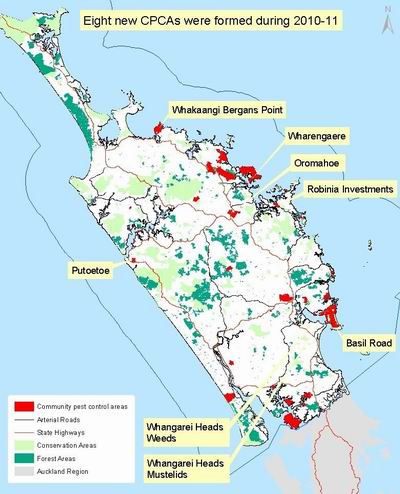Pest control
During 2010-2011, the council Biosecurity team responded to 887 enquiries in relation to pest management with around 47 percent of these about vertebrate animal pests.
Biosecurity staff carried out monitoring and/or control of:
· Pest plants – including Manchurian wild rice (330 sites), Nassella tussock (11 properties), spartina (nine harbours), African feather grass (more than 90 sites), Bathurst bur (132 sites), nodding thistle (161 sites), lantana (over 100,000 hectares) and hornwort (seven dune lake systems).
· Invertebrate pests – including guava moth (two trial sites), tropical grass webworm (six properties), gum leaf skeletoniser and pest ants, such as Argentine ants (two community plans).
· Pest animals – including possums, mustelids, cats, rats and goats; (35 site-led plans); and
· Maritime invaders – such as sea squirt (three sites).
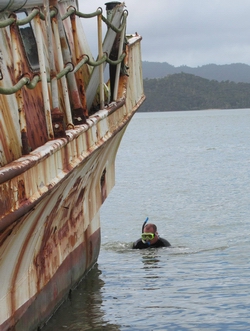 Inspecting for marine pests on the hull of a boat.
Inspecting for marine pests on the hull of a boat.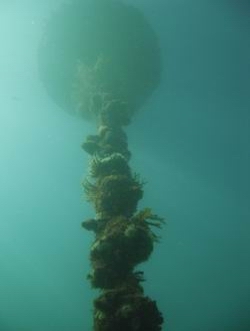 Styela clava on a mooring buoy.
Styela clava on a mooring buoy.
Pest plants
Manchurian wild rice
In Northland, Manchurian wild rice (MWR) covers approximately 500 hectares. It is widespread in the Kaipara district, with the main infestation found next to the Northern Wairoa River and its tributaries. There are also a small number of sites in Whāngārei, Kerikeri, and Mangakāhia.
The Northland Regional Council is working with the Ministry of Agriculture and Forestry (MAF) to ensure the containment, reduction and eventual eradication of Manchurian wild rice within Northland.
The programme has focussed mainly on eradication of outlier sites, those sites not connected to the main infestation area. Additional MAF funding during 2010-2011 also allowed sites within the containment area to be included in the eradication programme.
Infested sites require repeated spraying and a programme of sustained control is necessary for eradication of the plant at each site. Sites which have been under an active control programme for three years or more are showing a steady decline in the number of plants and percentage ground cover and there are more sites with only scattered juvenile plants or none at all.
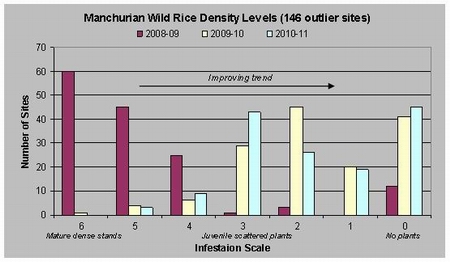
Hornwort and egeria (oxygen weed)
In May 2009, grass carp were released into Lake Roto-otuauru (Swan) on the Poutō peninsula to control these very invasive aquatic plants. Lake Swan is the only lake on the Poutō peninsula to have hornwort so it was vital to control it before it could spread to other neighbouring, high value lakes.
Progress with the eradication of hornwort and Egeria has been rapid with nearly all traces of these weeds removed in two years. Annual monitoring completed in March 2011 found only a few fragments of hornwort remaining on the lake margins. The risk of transfer of these weeds to neighbouring high value lakes is now near zero.
An expected decline in water quality – higher nutrients and algae numbers, and lower water clarity – has been seen in the lake, most likely because of the removal of submerged weed species. It's likely the weeds enhanced water clarity by taking nutrients from the water column and also stabilising bottom sediments. However, worsening water quality would have been likely had the weed beds been left unmanaged as they become over-populated and collapse.
Grass carp were introduced to Lake Heather, Aupōuri peninsula, in June 2010 as part of a programme aimed at eradicating both hornwort and Egeria and reducing the risk of these weeds spreading to nearby high-value lakes.
Monitoring completed in March 2011 showed that the Egeria had been heavily grazed and reduced to basal stalks and about 20 percent of the hornwort had been removed. Most of the hornwort remained and was still recorded up to 3.4m tall in places. The rate of progress for the grass carp to remove the weed beds is similar to that seen in Lake Swan, and it is likely the hornwort will be almost gone by March 2012.
Pest invertebrates
Community projects to control and manage Argentine ants at Skudders beach, Kerikeri and Mangaiti bay, Whananaki North have both completed the fifth and final years under existing management plans. They have been successful in reducing pest ant populations to acceptable levels however the challenge for local communities will be to maintain the effort required to organise baiting and ongoing monitoring.
A community project in Bland Bay is in its third year, and ants are now contained to a small part of their previous extent. A new plan has started this year in Basil Road, Whāngārei Heads and initial control work was completed during summer. Control has been highly successful in reducing ant numbers across an area of approximately 11 hectares.
Biocontrol
Few people realise it but Northland is a battleground for a largely unseen war between a host of tiny insects and fungi and some of the region's worst weeds. In the last five years alone, more than 50 releases of different ‘biocontrol' agents have occurred in Northland to help control weeds such as Californian, nodding and Scotch thistles, alligator weed, broom, gorse, mistflower and ragwort.
In 2010-2011 further progress was made to establish nursery sites for biocontrol agents, releasing and identifying new agents and nurturing existing agents in Northland. New releases of weed biocontrol agents include:
· Three releases of the tobacco weed lacebug;
· Two releases of the Tradescantia leaf beetle;
· The release of the broom gall mite; and
· The nodding thistle crown root weevil.
For more information visit www.nrc.govt.nz/biologicalcontrol
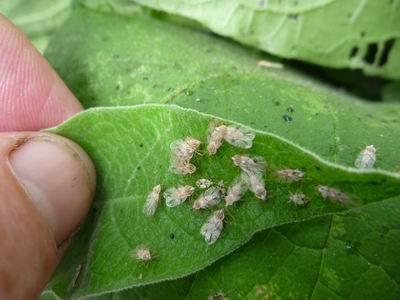 Woolly nightshade lacebug.
Woolly nightshade lacebug.
Community projects
Community projects (CPCA) which target multiple pest species are increasingly popular and regional council staff have now helped set up 35 community plans – eight in the last year – involving more than 800 people, and 32, 675 hectares of land.
Community plans are used to help support the protection of kiwi and other endangered fauna as well as deliver weed control.
Map of CPCAs in Northland
Click the image below to view a larger version in pdf format (141 kb)

